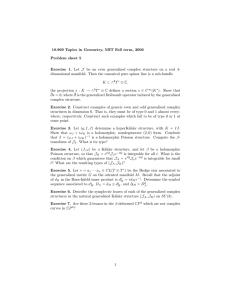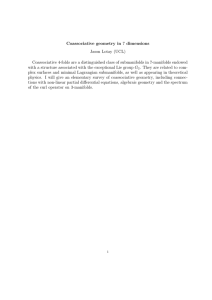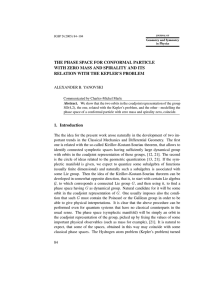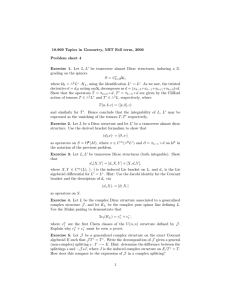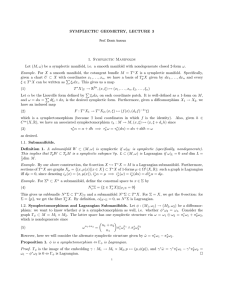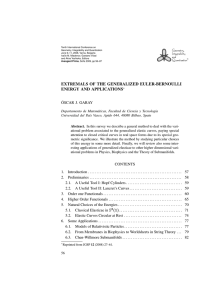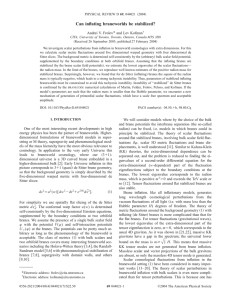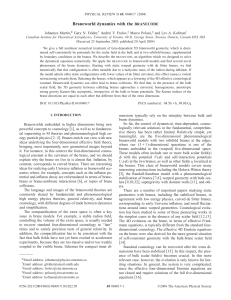15 Lecture 20 (Notes: K. ... 15.1 Generalized Complex Branes (of ...
advertisement
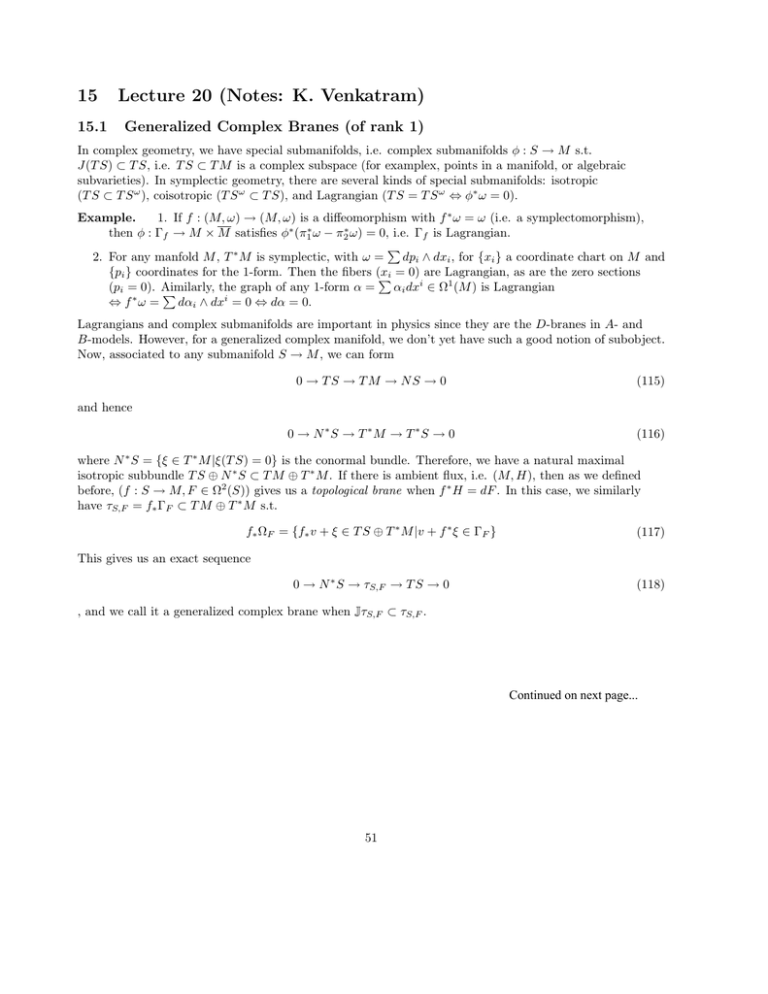
15
15.1
Lecture 20 (Notes: K. Venkatram)
Generalized Complex Branes (of rank 1)
In complex geometry, we have special submanifolds, i.e. complex submanifolds φ : S → M s.t.
J(T S) ⊂ T S, i.e. T S ⊂ T M is a complex subspace (for examplex, points in a manifold, or algebraic
subvarieties). In symplectic geometry, there are several kinds of special submanifolds: isotropic
(T S ⊂ T S ω ), coisotropic (T S ω ⊂ T S), and Lagrangian (T S = T S ω ⇔ φ∗ ω = 0).
Example.
1. If f : (M, ω) → (M, ω) is a diffeomorphism with f ∗ ω = ω (i.e. a symplectomorphism),
then φ : Γf → M × M satisfies φ∗ (π1∗ ω − π2∗ ω) = 0, i.e. Γf is Lagrangian.
�
2. For any manfold M , T ∗ M is symplectic, with ω =
dpi ∧ dxi , for {xi } a coordinate chart on M and
{pi } coordinates for the 1-form. Then the fibers (x
=
as are the zero sections
i
� 0)i are Lagrangian,
1
(pi = 0). Aimilarly,
the
graph
of
any
1-form
α
=
α
dx
∈
Ω
(M
)
is
Lagrangian
i
�
⇔ f ∗ω =
dαi ∧ dxi = 0 ⇔ dα = 0.
Lagrangians and complex submanifolds are important in physics since they are the D-branes in A- and
B-models. However, for a generalized complex manifold, we don’t yet have such a good notion of subobject.
Now, associated to any submanifold S → M , we can form
0 → TS → TM → NS → 0
(115)
0 → N ∗S → T ∗M → T ∗S → 0
(116)
and hence
where N ∗ S = {ξ ∈ T ∗ M |ξ(T S) = 0} is the conormal bundle. Therefore, we have a natural maximal
isotropic subbundle T S ⊕ N ∗ S ⊂ T M ⊕ T ∗ M . If there is ambient flux, i.e. (M, H), then as we defined
before, (f : S → M, F ∈ Ω2 (S)) gives us a topological brane when f ∗ H = dF . In this case, we similarly
have τS,F = f∗ ΓF ⊂ T M ⊕ T ∗ M s.t.
f∗ ΩF = {f∗ v + ξ ∈ T S ⊕ T ∗ M |v + f ∗ ξ ∈ ΓF }
(117)
This gives us an exact sequence
0 → N ∗ S → τS,F → T S → 0
(118)
, and we call it a generalized complex brane when JτS,F ⊂ τS,F .
Continued on next page...
51
15.1.1
General Properties of Generalized Complex Branes
• (f : S → (M, H), F ∈ Ω2 (S)) has generalized pullback map eF f ∗ : Ω∗ (M ) � ρ �→ eF f ∗ ρ ∈ Ω∗ (S) s.t.
deF f ∗ ρ = dF ∧ eF f ∗ ρ + eF f ∗ dρ = eF f ∗ (dρ + H ∧ ρ) = eF f ∗ dH ρ
(119)
∗
∗
(M, R) → HH
(S, R).
Thus, we obtain a map on cohomology HH
�∗ ∗
• Let ψ be the pure spinor line in
T M |
S defining τM,S Then ψ = �e−F det (N ∗ )� and Jτ ⊂ τ
implies that
0 = (Jx)ψ = [J, x] · ψ = J(x · ψ) + x · J ·
ψ∀x ∈ τ
(120)
Thus, Jψ = (ik)ψ: since ψ is real, k = 0, and ψ ∈ U 0 .
• Gerbe interpretation: for G = (Lij , mij , θijk ) a gerbe, (�ij , Bi ) a connection, if we can find (Li , �i )
on S s.t. F (�i ) − F (�j ) = F (�ij ), then F (�i ) − Bi = F is the gloabl 2-form on S we described.
• Action by B-fields: eB � T ⊕ T ∗ , (S, F + B).
Example. Examples of generalized complex branes:
1. Complex Case: f : (S, F ) → (M, J)(H = 0). Then
τS,F = {v + ξ ∈ T S ⊕ T ∗ M |iV F = f ∗ ξ}
JτS,F = τS,F ⇔ J(T S) ⊂ T S and − J ∗ F v = F Jv ⇔ S is a complex submanifold and F has type (1, 1)
(121)
Thus, we interpret F = F (�) as the curvature of a unitary connection on a holomorphic line bundle
L, giving us the complex brane (S, L, �).
2. Symplectic Case: For H = 0, F = 0, we have
�
��
� �
�
−ω −1
TS
TS
�
J =
=
⇔ ω(T S) = N ∗ S and ω −1 (N ∗ S) = T S ⇔ T S ⊂ T S ω and T S ω ⊂ T S
ω
N ∗S
N ∗S
(122)
i.e. iff S is Lagrangian. For F �= 0, things are more interesting. Choose locally an extension of F to
Ω2 (M ). Then Jω fixes τS,F ⇔ eF Jω e−F fixed τS,0 ⇔
�
��
� �
�
−ω −1 F
−ω −1
TS
TS
=
(123)
ω + F ω −1 F F ω −1
N ∗S
N ∗S
That is, we must have
• ω −1 N ∗ S ⊂ T S, i.e. S is coisotropic
• F (T S ω ) ⊂ N ∗ S, i.e. F vanishes on the characteristic foliation C, i.e. locally
F = π ∗ {, π : S → S/C.
• ω −1 F � T S s.t. (ω + F ω −1 F )T S ⊂ N ∗ S), i.e. on T S/T S ω , (1 + ω −1 F ω −1 F ) = 0, i.e.
(ω −1 F )2 = −1. Thus, T S/T S ω inherits a complex structure.
Note that F + iω defines a form of type (2, 0) on T S/T S ω w.r.t. I = ω −1 F since
I ∗ (F + iω) = F ω −1 (F + iω) = −ω + iF = i(F + iω) = (F + iω)I
(124)
and F + iω is closed. Thus, F + iω defines a holomorphic symplectic structure on SC, which therefore
must be 4k-dimensional. This is precisely the geometry discovered by Kapustin and Orlov as the
most general rank 1 A-brane in a symplectic manifold.
52
Example. Let (g, I, J) be a hyper-K ahler manifold, and consider the complex structure ωI .
Example. If S = M , then the conditions are (ω −1 F )2 = −1, i.e. F + iω is a holomorphic symplectic
structure. For example, (M, g, I, J) hyperk ahler with ω = ωk , F = ωJ , ω −1 F = ωJ−1 ωk = (gJ)−1 gk = −I.
This is an example of a space-filling rank 1 A-brane used by Kapustin-Witten in their study of the
geometric Langlands program.
15.1.2
Branes for Other Generalized Complex Manifolds
�
Consider a complex structure I, deformed by a holomorphic bivector β: Q = β + β, J =
I
Q
−I ∗
�
is a
generalized complex strucutre, e.g. CP 2 .
0-Branes: Before deformation, all the points were branes. Now, only the points on β = 0 are.
2-Branes: Branes must be complex curves where β = 0 or (β + iω)-Langrangian where β =
� 0. That is, β = 0 is
a brane, as is any curve on which β + iω = β −1 vanishes. In particular, any previous complex curve is
still a brane.
Problem. Are there 2-branes in CPβ2 which are not complex curves in CP 2 ? What are the space-filling
branes on CPβ2 ?
53
